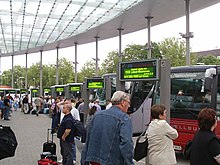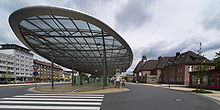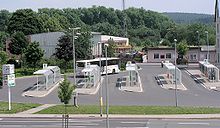Bus station
![]()
This article is about a major bus stop facility. For a depot, see Depot (transport).
![]()
This article or paragraph presents the situation in Germany. Help describe the situation in other countries.
![]()
The article is not sufficiently supported by evidence (for example, itemised). Information without sufficient evidence may be removed soon. Please help Wikipedia by researching the information and adding good evidence.
A bus station (Busbhf, Busbf or Bbf for short), also Omnibusbahnhof (Obf), Bushof or Busterminal, is a larger bus stop facility that serves as a - usually central - connection point for various bus lines. This is a traffic area with road access, which is used by buses. Bus platforms (analogous to platforms in a railway station) are created for passengers to get on and off the buses, and the buses stop at these platforms. In order to link up with the railway, underground or tramway, combined platforms are sometimes built when bus stations are newly built or rebuilt.
In Germany, the abbreviated designation ZOB (Zentraler Omnibus-Bahnhof) is often used, although the abbreviations ZUM for Zentrale Umsteigestelle, ZUP for Zentraler Umsteige-Punkt or ZOH for Zentrale Omnibus-Haltestelle are also used alternatively. An outdated designation is Gummibahnhof.

Germany's first ZOB in Flensburg, state of construction since 1996
Location
Germany's first ZOB, the Flensburg Central Bus Station, was opened on 31 December 1931 in the converted old Flensburg railway station, i.e. in a central location in the city. In 1951, the concept of the Hamburg ZOB (new building 2003) with its bus platforms and a common central building became pioneering for long-distance bus transport throughout Europe.
Bus stations are still generally found in central locations either near a railway station or in the city centre. A distinction should be made between urban or local transport interchanges and interchange points for long-distance bus lines.
An exception to the rule of a central location is the ZOB Berlin, which is neither located in the Berlin city centre nor near a (long-distance) railway station. Without an additional footpath, it is only directly connected to the bus network of the Berlin public transport company; a distance of a few hundred metres must be covered on foot to the underground and S-Bahn. Long-distance buses reach it via the nearby city motorway (AVUS). Another exception is the central bus station in Stuttgart. As a result of the construction work for Stuttgart 21, the previous location opposite the main railway station was closed on 1 April 2010, and buses temporarily departed from two locations in the districts of Obertürkheim and Zuffenhausen. The new central bus station at Stuttgart Airport has been in operation since 10 May 2016.
In many countries, long-distance bus services are much more important than in Germany. Here, bus stations with the dimensions of a main railway station or a smaller airport are often found, for example Kampin keskus, which opened in Helsinki in 2005, or the Esenler bus station in Istanbul, the largest bus station in Turkey and one of the largest in the world.
A bus station is often located in the immediate vicinity of a railway, rapid transit (S-Bahn, U-Bahn) or light rail station in order to make it easier for passengers to transfer between public transport modes. Attention is paid to short distances, sufficient passenger information and barrier-free design, including, for example, markings for the visually impaired. However, there are also places that do not have a track connection at all, but do have a bus station where several bus lines meet. To make boarding easier, even with prams, luggage or wheelchairs, there are sloping kerbs next to raised kerbs.
.JPG)
The ZOB in Flensburg is located at the tip of the harbour and centrally in Flensburg's city centre.
Designs
There are different designs for bus stations. These are:
- Roundel shape
- Oblique and longitudinal parallel form
- Kaiform
- Dog Bone Shape
Roundel shape
The roundabout shape is one of the most typical designs for bus stations, especially in urban traffic. In the roundabout form, the bus station consists of an ellipse in a central shape, around which the buses pass in left-hand traffic (in countries with left-hand traffic: right-hand traffic). It allows very easy turning, which is often important in urban traffic. In order to save space, the roundel shape can be equipped with indentations to the so-called "sawtooth shape", which allows easy entry and exit of the buses.
Parallel form
There are two types here, the diagonal and the longitudinal parallel form. Here, the individual bus platforms are arranged parallel to each other, either longitudinally or diagonally. This form has the advantage over the roundabout form that buses of different directions are separated from each other, but has the disadvantages of space consumption and the lack of parking space and often the lack of turning possibilities.
A special form of bus station exists at the ZOB in Passau. This has a rendezvous system and the buses stop in both directions in parallel due to a lack of space. It has two entrances/exits in both directions. Since it can be approached from the south as well as from the north, only five large bus platforms are needed, and the ZOB is only approached by city traffic and regional bus lines departing to the southwest.
Kaiform
The Kaiform is a certain construction method of the parallel form, however, with the difference that here perpendicular to the parallel bus platforms the waiting area for passengers is led. Thus, these are bus bays in which the buses stop. The kaiform has the advantage that the signage can be read very well; however, it requires the buses to back up when pulling out. Therefore, it cannot be used in public transport, but only in long-distance bus transport.
Dog Bone Shape
Dog bone shape means that the buses stop in a normal street on bus lanes, similar to the longitudinal parallel shape, and turn behind these bus lanes in a roundabout. Since the roundabouts are on both sides, the bus station has the appearance of a dog bone or a dumbbell from a bird's eye view.

ZOB Hamburg - in front of the bus platforms. Construction Kaiform

Bus station in Herne. Example of a roundel shape

Bus station in Ilmenau. Example of a parallel form
Search within the encyclopedia